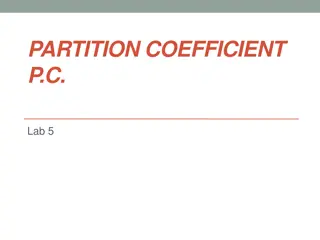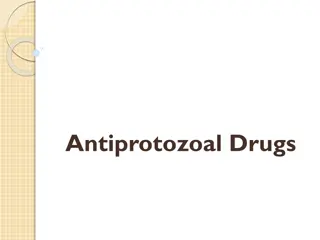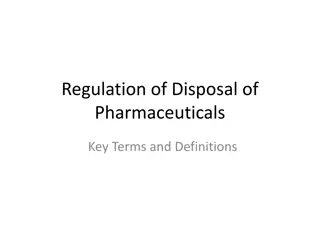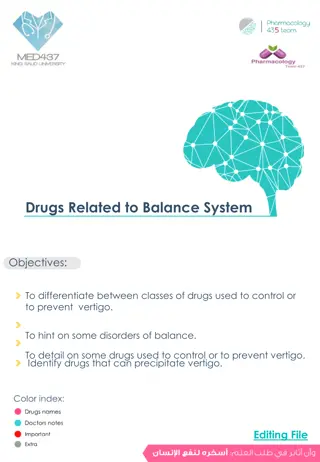Understanding Regulatory Requirements of Drugs and Pharmaceuticals
Drug regulation involves controlling drug use through international agreement authorities like the FDA, EMA, and PMDA. The FDA plays a crucial role in drug evaluation and research, biologic evaluation, devices, and food safety. There are various types of applications for drug approval, along with a detailed process from pre-clinical testing to market approval. Investigational New Drug (IND) applications are submitted for safety and effectiveness testing. Different types of INDs include Investigator IND and Emergency Use IND. The regulatory process ensures the safety and efficacy of drugs before they reach the market.
Download Presentation

Please find below an Image/Link to download the presentation.
The content on the website is provided AS IS for your information and personal use only. It may not be sold, licensed, or shared on other websites without obtaining consent from the author. Download presentation by click this link. If you encounter any issues during the download, it is possible that the publisher has removed the file from their server.
E N D
Presentation Transcript
REGULATORY REQUIREMENTS OF DRUGS AND PHARMACEUTICALS
DRUGS REGULATION Drug regulation is the control of drug use by international agreement authorities such as Administration (FDA), the Agency (EMA) and the Japanese Pharmaceutical and Agency (PMDA). This includes Medical Devices regulations concerned approval, manufacturing and marketing of drugs. and/or US European by regulatory and Medicinal the Food Drug with the development,
FDA Role and Organization FDA is organized into a number of offices and centers headed by a commissioner who is appointed by the President with consent of the senate These offices and centers are assigned with different responsibilities to accomplish the objective ofFDA 1. Center for Drug Evaluation and Research (CDER) 2. Center for Biologic Evaluation and Research (CBER) 3. Center for Devices and Radiological Health (CDRH) 4. Center for Food Safety and Applied Nutrition (CFSAN) 5. Center for Veterinary medicine (CVM)
TYPES OF APPLICATIONS Investigational New Drug Application New Drug Application Abbreviated New Drug Application Biologic License Application Over-the-counter (OTC) drug application
ClinicalHold PRE-CLINICALTESTING (4+YEARS) Revision ChemicalSynthesis and Scale uptesting DrugDiscovery and LeadCompound Selection Biologic Activitytesting (invivo) Formulation developmentand stability INDApplication IND Filing SafetyTestingin Animals IND Approval CLINICALTESTING (6+YEARS) Phase IIIClinical trials Phase II Clinical trials Phase I Clinicaltrials Revision NDA Filing FDAConditional Approval FDADisapproval FDAApproval MARKET Post-ApprovalSafety report toFDA Fig: the new drug approvalprocess
Investigational New Drug (IND) It deals with a new chemical entity, which will be tested for obtaining evidence of safety and effectiveness in accordance with the regulation. It is the vehicle through a new drug advances into next stage of drug development i.e. Clinical trials
Types of INDs 1. Investigator IND:- It is submitted by a physician who initiates and conducts an investigation, and under whose immediate direction the investigational drug is administered or dispensed. A physician might submit a research IND to proposed studying an unapproved drug, or an approved product for a new indication or in a new patient population. Emergency Use IND:-This allow the FDA to authorize an experimental drug in an emergency situation that does not allow for submission of an IND in accordance with 21CFR, Sec. 312.23 0r Sec.312.20. It is also used for patient who do not meet the criteria of an existing study protocol, or if an approved study protocol does not exist. 2.
3. Treatment IND:- It is submitted for experimental drugs showing promise in clinical testing for serious or immediately life-threatening conditions while the final work is conducted and the FDA review takesplace.
Criteria for application A clinical study is required for an IND if it is intended to support a: New Indication. Change in the approved route of administration or dosage level. Change in the approved patient population or a population at greater or increased of risk . Significant change in the promotion of an approveddrug
Application Content Animal Pharmacology and Toxicology studies. Chemistry and Manufacturing Information. Clinical Protocols and Investigator Information.
NEW DRUG APPLICATION (NDA) The New Drug Application (NDA) is the vehicle in the United States through which drug sponsors formally propose that the FDA approve a new pharmaceutical for sale and marketing. NDA is responsible for are providing enough information to permit FDA reviewersto establish the following: Whether the drug safe and effective in its proposed use(s) when used as directed, and do the benefits of the drug outweigh the risks. Whether the drug s proposed labeling (package insert) appropriate, and what should it contain. Whether the methods used in manufacturing (Good Manufacturing Practice, GMP) the drug and the controls used to maintain the drug s quality adequate to preserve the drug s identity, strength, quality, and purity.
Fundamentals of NDA Submission As outlined in Form FDA-356h, Application to Market a New Drug for Human Use Or As An Antibiotic Drug For Human Use, NDAs can consist of as many as 15 different sections: Index Summary Chemistry, Manufacturing, and Control; Samples, Method Validation Package, and Labeling Nonclinical Pharmacology and Toxicology Human Pharmacokinetics andBioavailability Microbiology (for anti-microbial drugs only);
ClinicalData; Safety Update Report (typically submitted 120 days after the NDA's submission); Statistical; Case ReportTabulations; Case ReportForms; PatentInformation; Patent Certification;and Other Information
Classification of drugs in NDA CDER classifies new drug applications with a code that reflects both the type of drug being submitted and its intended uses. New Molecular Entity New Salt of Previously Approved Drug (not a new molecular entity) New Formulation of Previously Approved Drug (not a new salt OR a new molecular entity) New Combination of Two or More Drugs Already Marketed Drug Product - Duplication (i.e., new manufacturer) New Indication (claim) for Already Marketed Drug (includes switching marketing status from prescription to OTC) Already Marketed Drug Product - No Previously Approved NDA
GENERAL REQUIREMENTS for filing an NDA The new (present) NDA regulations require that an application be submitted in two copies : (A)an archival copy that serves as a permanent record of the submission, and (B) a review copy. The review copy is made up of a number of separate technical volumes, each tailored to the needs of the disciplines involved in the review. Both the archival and review copies are submitted in hard copy, the regulations permit an application to submit the archival copy as microfiche. The NDA application form (FORM FDA 356h ) consists of: Twelve items (including index) deals with the safety and efficacy features of drug product, two are concerned with patent information
The archival copy is a complete copy of an application submission and must be bound in a blue coverjacket. The archival copy should include a blue cover letterto: Confirm any agreement or understanding between the FDA and the agreement; Identify the contact person regarding the application Identify the reviewing division of the FDA and include HFD number; Convey any other important information about the application.
The review copy is divided into six technical sections (review sections) and should be submitted with each review section separately bound in a specific color: REVIEW SECTION COLOUR CODE (i) Chemistry, Manufacturing and Controls(CMC) RED (ii) Nonclinical Pharmacology andToxicology YELLOW (iii) Human Pharmacokinetics and Bioavailability ORANGE (iv) Microbiology (if required) WHITE (v) ClinicalData LIGHT BROWN (vi) Statistical GREEN
Each review section should contain the following: (i)a copy of the cover letter attached to the archival copy; (ii) a completed application form FDA356h; (iii) a copy of the summary (defined below); (iv) a copy of the general index of the entire application; (v) an index specific to that particular review section; (vi) letters of reference or authorization, if appropriate; (vii) patent information
ABBREVIATED NEW DRUG APPLICATION In addition to approving new drug products , the FDA is charged with the approval of generic products (21 CFR 314), which is accomplished through CDER s Office of Generic Drugs. An Abbreviated New Drug Application (ANDA) contains data submitted to FDA's Center for Drug Evaluation and Research, Office of Generic Drugs, for review and ultimate approval product. The reviewing process for generic drug is focused on bioequivalence testing efficacy. of a generic drug rather than safety and
To be considered bioequivalent, both rate and extend of drug absorption must be within established parameter in comparison to the reference drug. Use of bioequivalence as the base for approving generic drug products was established by the "Drug Price Competition and Patent Term Restoration Act of 1984," also known as the WAXMAN-HATCH ACT.
Guidelines available forANDA: Various guidelines have been developed to assist applicants in preparing and filingANDAs Format & content for the following sections: a. Applicationsummary b. Chemistry, Manufacturing and controls section c. Non clinical pharmacology and toxicology section d. Human pharmacokinetics & bioavailability section e. Clinical and statically section f.Microbiology section
ANDA requires the submission of : Detailed descriptions of the components Manufacturing, controls, packaging, and labeling (which can be in final, printed form), data or sufficient bioequivalence of the drug to be marketed. The labeling should be prepared in accordance with that specified in DESI (Drug efficacy study implementation) Notice Register to assure the bioavailability or other Federal
COMPARISON NDA ANDA Applicable for new drug Take longer time ( 12-15 years) Applicable for genericdrug Compare to NDA less time taken(1-2years) Comparatively less Cost of drugs are less Nonclinical studies and clinical investigations are nonessential except bioavailability and bioequivalence More expenditure of money Cost of drugs are more Nonclinical studies and clinical investigations are essential
REFERENCES 1. The theory and practice of Industrial Pharmacy ,Leon Lachman and Herbert A. Lieberman Indian Edition 2009,page no. 856- 871 2. The Science and Practice of Pharmacy, Remington 21stEdition, Volume 1 . Page no 965-975. 3. http://www.fda.gov/AboutFDA/Transparency /Basics/ucm194879.htm























